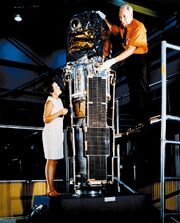
The Uhuru (X-ray Explorer Satellite) with Marjorie Townsend discusses the X-ray Explorer Satellite's performance with Bruno Rossi during preflight tests at NASA's Goddard Space Flight Center.
Data[]
| Category. | Statistic. | |
|---|---|---|
| Launch vehicle. | Scout B S175C rocket. | |
| Launch date. | December 12, 1970, 10:53:50 UTC. | |
| Launch site. | San Marco\Luigi Broglio Space Centre (BSC). | |
| Ceased operations. | March 1973 | |
| Owner(s). | NASA. | |
| Major contractor(s) . | NASA? | |
| Is it still in orbit. | No, it burnt up on April 5th, 1979. | |
| Launch mass. | 141.5 kilograms (312 lb). | |
| Nationality(s). | American (Italian\Kenyan join owned nautical launch site). | |
| Satellite type. | Astronomy. | |
| Links. | https://en.wikipedia.org/wiki/Uhuru_(satellite), http://heasarc.gsfc.nasa.gov/docs/uhuru/uhuru.html,https://en.wikipedia.org/wiki/Proportional_counter, http://www.physicswiki.net/index.php/Uhuru_(satellite) and http://heasarc.gsfc.nasa.gov/docs/uhuru/uhuru.html |
Instruments[]
The payload consisted of two sets of proportional counters, each with ~0.084 m2 effective area. The counters were sensitive with more than 10% efficiency to X-ray photons in the ~2–20 keV range. The lower energy limit was determined by the attenuation of the beryllium windows of the counter plus a thin thermal shroud that was needed to maintain temperature stability of the spacecraft. The upper energy limit was determined by the transmission properties of the counter filling gas. Pulse-shape discrimination and anticoincidence techniques were used to filter out emissions of particles and undesirable high-energy photons in the background.
One of it's tasks was Pulse-height analysis in eight energy channels was used to obtain information on the energy spectrum of the incident photons. The two sets of counters were placed back to back and were collimated to 0.52° X 0.52° and 5.2° X 5.2° (full width at half maximum) respectively. While the 0.52° detector gave finer angular resolution, the 5.2° detector had higher sensitivity for isolated sources.
A proportional counter is a type of gaseous ionization detector device used to measure particles of ionizing radiation. The key feature is its ability to measure the energy of incident radiation, by producing a detector output that is proportional to the radiation energy; hence the detector's name. It is widely used where energy levels of incident radiation must be known, such as in the discrimination between alpha and beta particles, or accurate measurement of X-ray radiation dose. A proportional counter uses a combination of the mechanisms of a Geiger-Muller tube and an ionization chamber, and operates in an intermediate voltage region between these. The accompanying plot shows the proportional counter operating voltage region for a co-axial cylinder arrangement.
Results[]
Uhuru achieved several outstanding scientific advances, including the discovery and detailed study of the pulsing accretion-powered binary X-Ray sources such as Cen X-3, Vela X-1, and Her X-1, the identification of Cygnus X-1, the first strong candidate for an astrophysical black hole, and many important extragalactic sources.
The Uhuru Cataloge[]
The Uhuru Catalog, issued in four successive versions, the last being the 4U catalog, was the first comprehensive X-ray catalog, contains 339 objects and covers the whole sky in the 2—6 keV band. The final version of the source catalog is known as the 4U Catalog; earlier versions were the 2U and 3U catalogs. Sources are referenced as, e.g., "4U 1700-37".
It's naming[]
The satellite's name, "Uhuru", is the Swahili word for "freedom". It was named in recognition of the hospitality of Kenya from where it was launched, from the Italian San Marco launch platform near Mombasa.